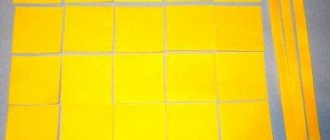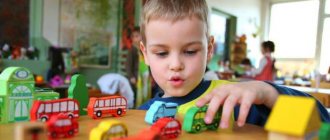MAGAZINE Preschooler.RF
Project “From grain to bread”Authors:
- Potanina Natalya Aleksandrovna – teacher,
- Vladimirova Vera Nikolaevna – teacher.
Relevance: Bread is a product of human labor, it is a symbol of well-being and prosperity. It is bread that has the most important place on the table both on weekdays and on holidays. Not a single meal is complete without it.
This product accompanies us from birth to old age. The value of bread cannot be measured by anything. But why do some children love bread and eat it with pleasure, while others refuse it?
Many children do not know about the work of people who grow bread and treat bread carelessly (throw it, play with it, crumble it, make figures, throw away half-eaten pieces).
The project is designed to draw children's attention to the efforts that make bread appear on our table, and to cultivate a caring attitude towards bread.
Project participants: teachers, senior kindergarten students, parents.
Project type: educational and research, short-term.
Type of project: group.
Educational areas:
- Social and communicative development
- Cognitive development
- Speech development
- Artistic and aesthetic development
- Physical development
Implementation period: short-term (2 weeks)
Goal: to form a holistic understanding of the process of growing bread in children of senior preschool age, to develop a caring attitude towards bread and the work of the people who grow it.
Tasks:
- Formation of knowledge about the diversity of cereals and bakery products;
- Form ideas about the long journey of bread from field to table;
- Promote the development of children's curiosity;
- Develop an aesthetic attitude towards the surrounding reality;
- Enrich children's vocabulary. Improve coherent speech skills;
- Develop the ability to apply acquired knowledge in productive activities;
- Encourage active participation in joint activities with adults and children;
- To cultivate a caring attitude towards bread and the work of people who create bread products.
Expected result:
- Children acquire the necessary knowledge about the production of bread and bakery products.
- To help instill in children a sense of respect for the hard work of people who grow bread.
- Involving parents in the pedagogical process.
IMPLEMENTATION PLAN
- Conversation about bread (preliminary, about children’s existing knowledge about the meaning of bread);
- Memorizing thematic poems, proverbs, sayings, reading stories;
- Educational lesson “Where did the bread come from” ;
- Organization of leisure activities “Guess the riddle by taste” ;
- Experimentation: “What happens when you mix water, flour and salt” ;
- View the presentation “Where the bread came from” ;
- Selection of books on the topic in the book corner;
- An excursion for children of the middle group “All about bread” is conducted by children of the older group.
PROJECT IMPLEMENTATION
Stage 1 – preparatory
- Selection of fiction for reading and memorizing poetry.
- Development of lesson notes “Where did the bread come from”
- Selection of illustrative material and presentations for project implementation.
- Making a didactic game “How to bake cookies” , “Pick up a part”
- Consultations for parents: “On the benefits of bread” , “A second life for stale bread” .
Stage 2 - main
Conversations: “How bread came to our table” ; “Who is the grain grower” ; “Bread is the head of everything!” ; “What kind of bread is there? ” “How to bake bread at home” ; “Bread is our wealth!” .
Examination of illustrations and reproductions: on the topic: “Growing bread” ;
examination of paintings by I. I. Shishkin “Rye” , I. I. Mashkov “Moscow Snack” , S.A. Kupriyanov “Plowing” , “Sowing” , “Harvesting” , “Winter crops” .
Watching documentaries: “The Story of Bread” ; “A secret to the whole world. How bread is made" ; “How bread is baked!” Program for children "ABVGDeyka" .
Watching cartoons: “Golden Ears” Belarusian fairy tale; "The story of the girl who stepped on bread" . Based on the fairy tale by Hans Christian Andersen; "Kolobok" Russian folk tale; “Bread” Belarusian fairy tale; “Miracle - the mill!” Russian folktale.
Introduction to professions: agronomist; combine operator; baker; confectioner; salesman.
Research activity: examining and comparing grains with a magnifying glass (rye, wheat, barley, oats).
Building a diagram “Stages of growing bread” .
Experimental activities: turning grain into flour (mortar, coffee grinder); growing seeds (rye, wheat, barley, oats); preparing salted dough for modeling.
Speech development:
Reading fiction about bread: Fairy tales: “Light bread” , “Krupenichka” , “Winged, furry, and buttery” , “Spikelet” ; V. Datskevich “From grain to loaf” ; K. Chukovsky “Miracle Tree” , “Bulka” ; V. Remizov “Bread Voice” ; Y. Akim “Bread” ; T. Shorygina “A Loaf of Bread” ; I. Tokmakova “What is bread” ; N. Samkova “About Bread” ; Riddles, tongue twisters, proverbs, sayings, poems, signs about bread.
Story based on pictures: “How in the old days people grew bread!”
Social and communicative development:
Role-playing games: “Family” ; "Shop" ; "Bakery" ; "Cooking" .
Didactic games: “Name the profession” ; “What kind of flour were you baked with?” ; "The fourth wheel" ; "From grain to loaf" ; “What first, what then” ; "Transformations" ; "Wonderful bag" ; “Who can name more bakery products” ; “Guess by touch” ; “How to turn flour into dough?” ; “Call me kindly .
Physical development:
Outdoor games: “Who can reap the harvest faster” ; round dance game "Loaf" .
Artistic and aesthetic development:
Visual activity: looking at paintings and illustrations about bread; modeling bakery products from salt dough with children for the role-playing game “Bakery” ; making pictures from semolina; image of grain fields; people growing bread, bakery products, application “Bouquet of ears of wheat” .
GCD: “Where does bread come to us from” ; “Bread is the head of everything” ; Compilation of stories based on a series of paintings “How people grow bread” ; Conversation: “What would you like to become?” (professions of grain grower, baker...).
Interaction with parents: invite children, together with their parents, to find and learn poems, proverbs and sayings about bread; production of a group cookbook “Recipes of our grandmothers” ; theatricalization of the Russian folk tale “Spikelet” ; invite parents to create a photo report “Secrets of Family Baking” .
Final event: design of the mini-museum “Bread is the head of everything!” .
Stage 3 - final
Analysis and generalization of acquired knowledge.
Conclusion: the children’s level of knowledge on this topic has increased. They gained new knowledge about the production of bread and bakery products, about people of different professions associated with growing and baking bread, that their work is necessary, but very difficult. The knowledge gained will have a great influence on the development of children's skills of tolerant attitude towards people of different professions.
| Next > |


